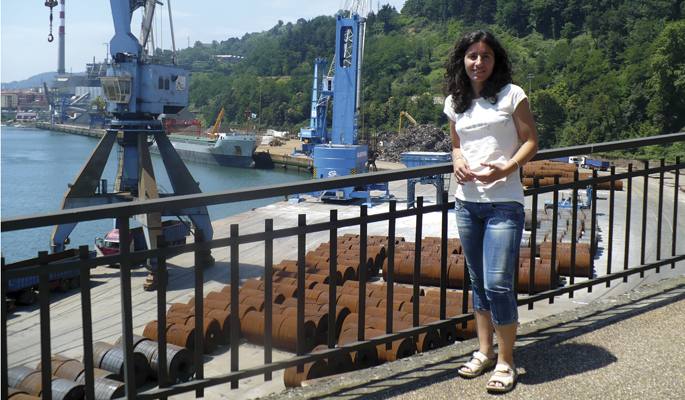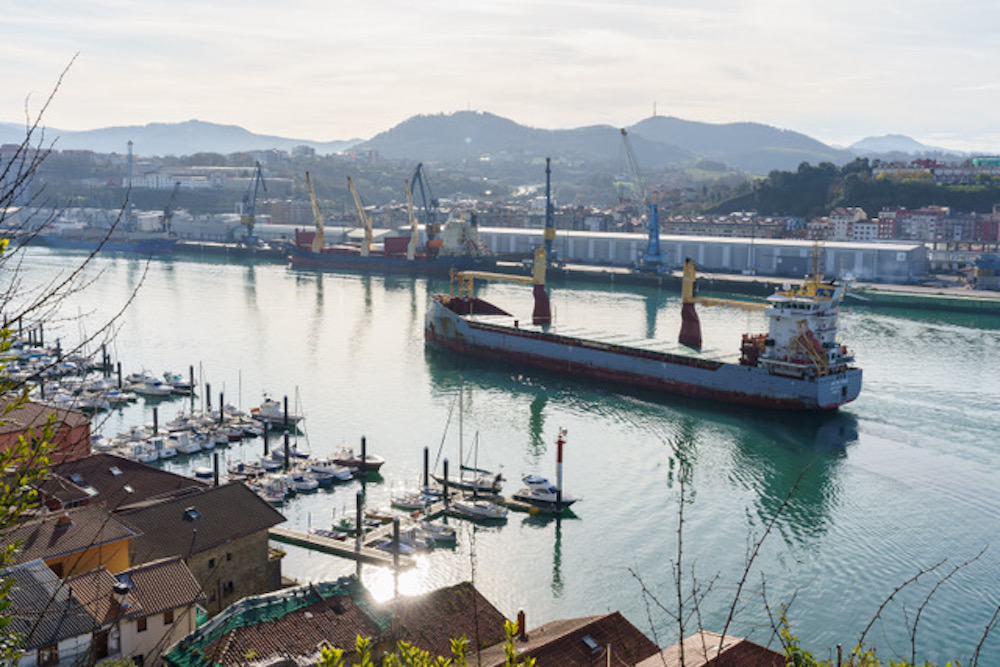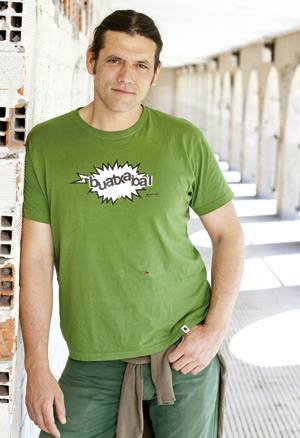"There is no project from the outside port of Pasaia"
- Leire Beteta now works as an external advisor in Lezo. We have gone to ask him about the external port of Pasaia and he has given us the instructions that we have not heard from the politicians.

You hear a big bang for the exterior pier of Pasaia. What is the project?
You called it a project, but there is no project in itself. What currently exists is a Plan that the Port Authority must carry out and which is called the Infrastructure Master Plan. In this regard, the Authority should determine the location of the port, the infrastructure needs and its economy. There is mention of the external pier, within this Master Plan. In other words, the only one that has appeared in the exterior port is the drawings, the designs, it is nothing more than a proposal within that guide plan.
The Port Authority is now processing in Madrid the environmental study of this master plan. It is precisely because of this analysis that the report prepared by the Spanish Ministry has arrived, which has been so resounding with this Master Plan, and in particular with the idea of the external port. The Ministry sees serious problems in the external port and they are not the only ones, so was the Environment Department of the Basque Government, which, in addition to an excessive environmental impact, does not see enough evidence to make it economically viable.
The report calls for the analysis of alternatives such as the care and improvement of the current port, something that the Authority has not taken into account at all.
Who has the final say in this matter?
If the Spanish Ministry of the Environment says it is unsustainable, it would be suspended. But now we are not dealing with the external port, but with the Infrastructure Master Plan. The Ministry of the Environment will therefore give its opinion on this plan and any changes to it will be those that will be made. What is not the examination of the Ministry? External springs. Therefore, you will have to change that idea and analyze the alternatives, whether it be the renewal of the internal pier, the logistic platform of Lezo, or the collaboration with the port of Bilbao… But once the plan will have to be approved in one way or another, since the Port Authority cannot move forward without that plan.
What are the deadlines?
The Authority and the Ministry work together. They must take forward the Environmental Report, another of the procedures established by law. In order for this report to go ahead, the Authority must respond to all the allegations and take into account that there were thousands, the majority opposed to the external pier. This report will analyse how the Authority has produced the Environmental Sustainability Report and what are the most significant impacts on the environment. Finally, it will also include the necessary changes in the Master Plan. It will take a long time.
The Ministry demanded rigorous studies on the impact of this external pier on the different marine habitats, as well as on the nuisance that traffic could cause for cetaceans, among others. Responding to all of this is not easy.
They also have to study the improvement of the interior pier…
That's what I'm most interested in. After all, no one wants the situation today, not even those of us who live here. We know that the quality of life is poor, but it is also true that no account is taken of it. We are told that the port and the city are incompatible, but they have never tried. There's a lot of work to do there.
Among the alternatives requested by the Ministry of the Environment, there is also the improvement of the port of today to make it compatible with the cities of the area. Therefore, the examination should be carried out successfully.
What about internal renewal?
I think it is possible. Good environmental practices are applied in many ports. I do not know, but at least that test will have to be done.
On the other hand, there is great uncertainty about the operation of the port. Ports are actually cargo unloading areas and that is what gives the money. Here you will see something else, and the numbers also show it, that this port is used as a warehouse for several companies. The dumping of scrap and the like takes place for months, and these practices are precisely the ones that cause problems, those gigantic piles of scrap that are neither covered nor collected. The dust that comes off while they're there, it's dragged by the wind into the inner city.
The loading system also knows when they are, no measures have been imposed to prevent the damage they cause... How does it justify the expulsion of this disaster? And it's curious, because that Infrastructure Master Plan says that when the pier leaves out, then yes, then you will take into account a lot of measures… Well, and why don't they start from today?
Do city councils have no capacity to do so?
The authority has a board of directors. It includes the Basque Government, the Spanish Ministry of Development, the trade unions and the municipalities. So, in the decision-making forums, they already have a voice and something to say. Of course, things change a lot depending on what political force it commands.
On the other hand, the Authority manages the port, but the land is from the municipality and the municipalities also have competence in this. Companies in port need municipal authorization to act. And I don't know why, maybe because the port isn't interested in making this permission known, but I would say that most companies don't have a municipal license. In the event that they have ever been left the city council has refused or claimed that the concession of the port is sufficient. It is sad, but if these licences are not managed, corrective action cannot be taken.
What would annoy the Exterior Pier?
To build the quay out, they won't touch the mountain. That is impossible. Well, it's just a tunnel, they say. But you'll have to explain how you're going to make the platform and the rest without touching the mountain -- magic? The construction of an infrastructure attached to the sea cliffs is proposed. Mount Jaizkibel is a protected area for Europe, but that is not going to be touched. Protection currently starts above zero meters. This platform, so that it is not swallowed by the sea, must be built from there, on the top of the mountain.
In addition, anyone who has approached the cliffs knows that the cliffs are very dynamic spaces, that the erosion is continuous, that the plants grow, that stones fall… Therefore, if you do not want the platform to deteriorate, you will have to maintain that slope. Won't you touch that mountain? A lot is to say.
On the other hand, the cliff, as its name suggests, is a space linked to the sea, if you put a 100-hectare platform in front of it, you'll tell me where that relationship is with the sea. As for the bottom of the sea, life in the area occupied by the platform will disappear.
The coast of Jaizkibel is the longest and longest virgin area on the Basque coast (15 kilometres). Like hawks or saizuris, many of the birds that are protected there nest because there are no aggressions, no impacts, no buildings… If conditions change, that wealth would disappear. All this, only with construction works.
Then, the noise, the pollution of the activity itself. Let's call it whatever you want, but that's to want to introduce an industrial space into a natural space. On the other hand, it is intended to bring the diesel, the oil, the tanks, this type of goods. We all know the risk of transport.
What should Mount Jaizkibel have and what protection should the area have?
Mount Jaizkibel has been part of the Natura 2000 European Network since 2004 and must have its corresponding management plan. The document is written, had a participatory process, received contributions from here and there, but it has not yet been approved. This process is standing still.
What does that mean, which is still unprotected?
No. As a result, the external quay has not gone ahead, and probably will not, as it is a protected area.
The Natura 2000 network aims not only to protect space, but also to improve. The management plan indicates which species are significant in Jaizkibel, which habitats need special care, where an extraordinary effort needs to be made. Because Jaizkibel, if he has something, is of great interest. As far as vegetation is concerned, there are many pine trees, but native trees can also be recovered, as is the case for mothers. This requires an appropriate action plan. Unfortunately, the document is kept in some drawer by the Basque Government.
Does it not have an expiry date?
In fact, by December last year it had to have been approved. That was the deadline that Europe had set for 6 years. The participation process was also carried out last year, but the document has not yet been released to the public exhibition. This is the protocol, before accepting it, you can make allegations. Then we have to give some time to receive, respond to and accept the contributions.
Does Europe not squeeze it?
It usually gives margin. The Jaizkibel case is not the only one. If it does not, however, you can go to Europe and make a complaint.
What can influence the complaint of the inhabitants here?
It is very important. A justification must be sought to accept something that may have a significant environmental impact. The opinion of the locals is very much to keep in mind, as it is not the same as the need for that, when everyone feels it, when local associations also agree.
Why do Jaizkibel-Ulia have protection up to zero? Why has the sea not been taken into account?
The protected areas of the Labour Coast take into account the two areas, they are terrestrial and marine, there are no zero-class divisions, because from an ecological point of view it is indivisible, it is what is known as intermareal. In the case of Jaizkibel, the Deputy Environmental Minister of the Basque Government explained that the area was not included in the Natura 2000 network because there was no maritime information. That's because of a lack of data. At present, however, more and more information is available and we know that the marine area of Jaizkibel and Ulia has sufficient values to access the Natura 2000 network.
Macarena Olona estatuko abokatuak eta portuko aholkulariak iazko apirilean salatu zuen fiskaltzaren aurrean Pasaiako portuko lonjaren eraikuntzan balizko ustelkeria kasua. Espainiako Estatu mailan indarrean daude ere beste hamar portutako ustelkeria kasuen ikerketak.

























